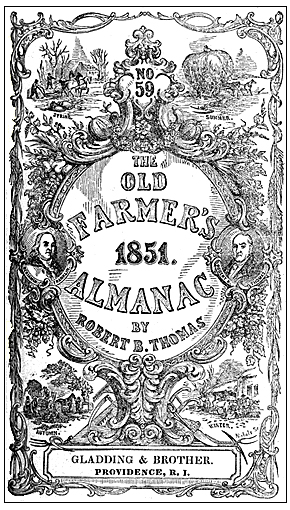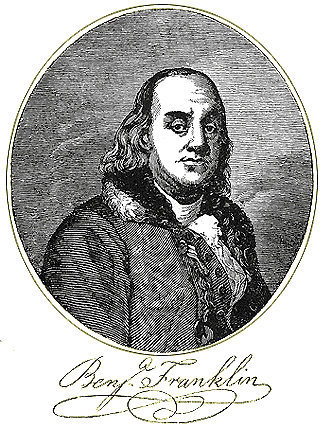Here is the history of the many engravings that have adorned the covers of The Old Farmer’s Almanac.
Main Elements of the Almanac Cover
Space for advertising seems to have been the original idea behind the introduction, in 1840, of The Old Farmer’s Almanac covers.
In addition to the title, year, and Robert B. Thomas’s name as author, the local bookseller’s name was printed in a blank space at the bottom of the front cover. The inside front cover and both sides of the back cover listed the books and stationary supplies for sale by the bookseller. The Almanac’s Boston printer apparently shipped naked Almanacs to outlying booksellers, who bound them with their own custom-printed covers, using colored paper.
Wood Engravings on the Cover
During the 1840s the front covers were decorated with a variety of small wood engravings: a sheaf of wheat (a symbol of all-important agricultural prosperity); Father Time (same as the title page); farm animals; a rural winter scene; a plowman; and a milkmaid. The wheat cut (1840, 1842, 1845) is the only one that contains the engraver’s initial, a capital “H.” It probably stands for Alonzo Hartwell (1805-1873), whose full last name appears in an advertising cut on the back cover of an 1851 Almanac. Hartwell was a pupil of Boston wood engraver Abel Bowen.
Two mid-century publications may have prompted the OFA to create its own full-page, standardized front cover—the four seasons, with portraits of Benjamin Franklin and Robert B. Thomas—that came into use in 1851 and has appeared ever since.

The Old Farmer’s Almanac began use of the “Four Seasons” cover design in 1851. It was designed by Hammatt Billings and engraved by Henry Nichols, whose name appears in the lower right.
Why Is Benjamin Franklin on the Cover?
In 1848, a biography of Benjamin Franklin was published, and it was illustrated with wood engravings by Alexander Anderson. This was followed by Poor Richard’s Almanac for 1850, as Written by Benjamin Franklin, the brainstorm of John Doggett Jr. of New York. It is a reprint of the famous original Poor Richard’s Almanack that appeared in 1733, but with current astronomical calculations. Doggett promised to reissue Franklin’s almanac each year until all the originals were reprinted, a task that would take 25 years. The elaborately engraved cover of Doggett’s almanac includes handsome lettering, stacks of wheat, farming scenes (including a plowman), and of course Ben Franklin.
The original Poor Richard’s was the first almanac to circulate extensively throughout the colonies and established Benjamin Franklin (1706-1790) as a popular national figure. At the height of its success in the mid-18th century, about 10,000 copies were printed annually, a whopping circulation for that day. Franklin’s mark of genius lay in his brief renditions of quaint sayings and wise admonitions:
He that lies down with dogs, shall rise up with fleas.
Having been poor is no shame, but being ashamed of it is.
The worst wheel of the cart makes the most noise.
Early to bed and early to rise, makes a man healthy, wealthy, and wise.
Some are weatherwise, some are otherwise.
Time is money.
In this world nothing can be said to be certain, except death and taxes.
These he wove down the astronomical columns of his almanacs, setting a high standard of literary achievement for future almanac publishers.
By the mid-1800s, Robert B. Thomas’s Old Farmer’s Almanac had become an institution, one of the few almanacs to make it out of infancy into old age. In 1851, the 59th consecutive edition, Ben Franklin and Robert Thomas first appeared together on the Almanac’s cover. With the new Franklin biography out, and Doggett’s commemorative 1850 almanac already making its way up and down the country, The Old Farmer’s Almanac took advantage of the opportunity by identifying its recently-deceased founder (Thomas died in 1846 at the age of 80) with the revered Franklin. We have no evidence that Franklin and Thomas ever knew each other—their portraits appearing together on the Almanac’s cover simply serve to link, in the public’s mind, worthy publishers of the two most successful almanacs to date.
Since it is known that the title-page cut and the twelve cuts of the months for the 1853 Almanac were drawn by Hammatt Billings of Boston, and engraved by Henry Nichols of Cambridge (whose name appears on the title-page cut), it is likely that Billings was the designer of the 1851 “four seasons” cover as well, for Nichols’ name also appears at the bottom right of the cover engraving.
Both the 1851 Almanac portrait of Ben Franklin by Billings and Alexander Anderson’s engraving that appeared in the 1848 Franklin biography were based on the so-called “Fur Collar” portrait, painted by Duplessis in 1778. Billings may even have copied the Anderson engraving, or almost certainly had seen it. The Franklin portrait on the front cover of Doggett’s Poor Richard’s Almanac for 1850 (a wood engraving by “J. W. Orr & Andrew, N.Y.”) is quite different: it’s based on the “Thumb Portrait,” a 1766 painting which shows the bespectacled Franklin resting his chin on the end of his thumb while reading.

Alexander Anderson’s 1848 engraving of Franklin may have served as the model for the Franklin portrait on The Old Farmer’s Almanac cover.
As for the Robert B. Thomas portrait that hangs opposite that of Franklin on The Old Farmer’s Almanac’s 1851 cover, Billings seems to have modeled it on Zedekiah Belknap’s 1836 painting of the Almanac’s founder, complete with long white sideburns. This painting is owned by the American Antiquarian Society in Worcester, Massachusetts.
Since 1851, the “four seasons” Billings cover, engraved by Nichols, has been used consistently every year up to the present time, although in 1988, a color-tinted zinc etching by Floridian David Hunter, based closely on the wood engraving, has been substituted.
Part I: Title Page or Frontispiece
Part II: Right-Hand Calendar Pages
Part III: Front Cover of The Old Farmer’s Almanac (above)
